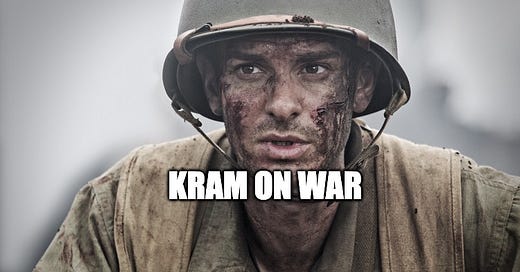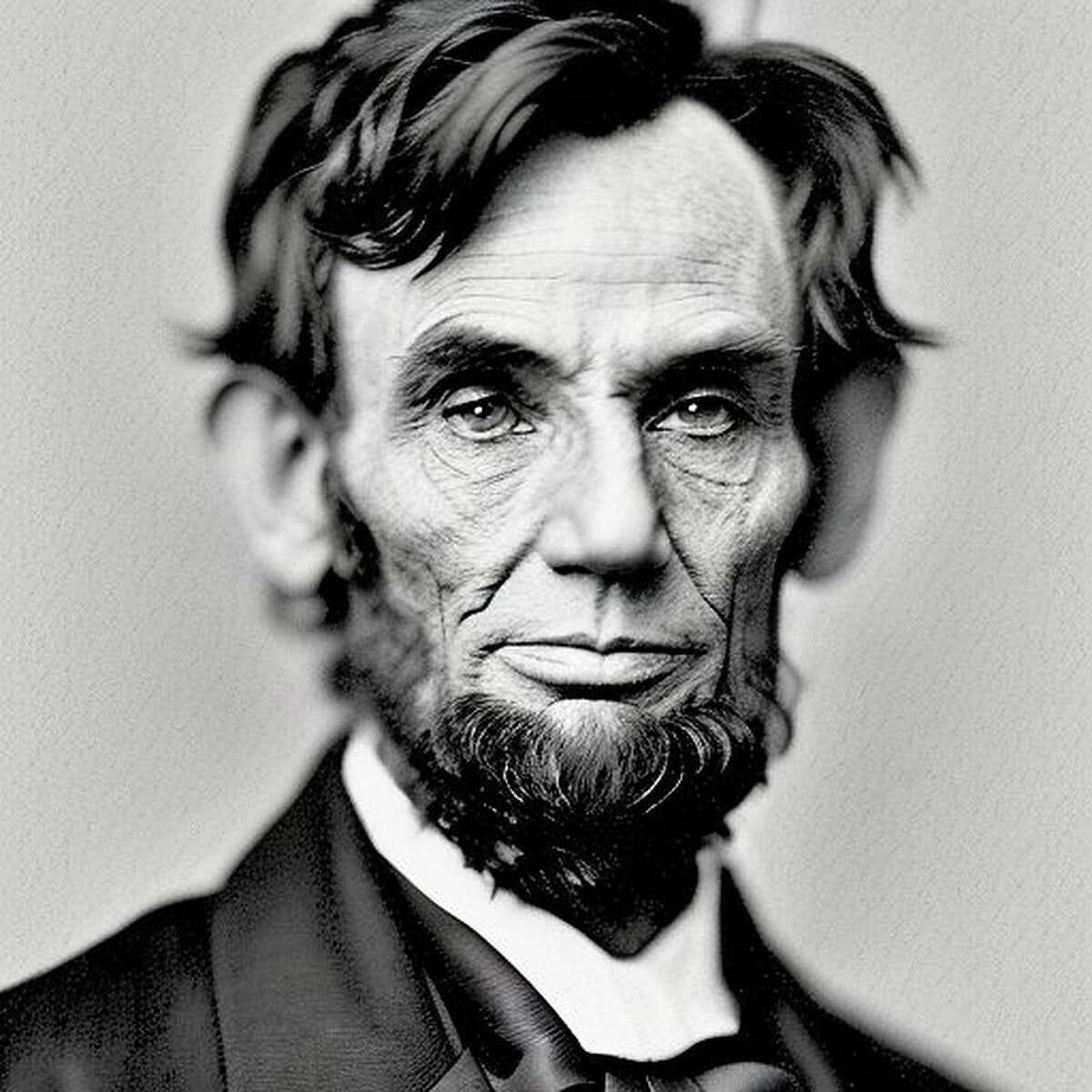alright, decided to write today. it’s been a while for kram. didn’t know if my fingers still worked. was attempting to type something fun and upbeat, but instead went down a really long “conscription in the US” internet rabbit hole, so i guess I’m writing about war. anyway, here are a few disparate thoughts on war, including 2 movie reviews (hacksaw ridge + oppy), the history of conscription in the US, facts about earthly wars, and a chatgpt poem.
war, war, this movie made me want to curl up on the floor.
Hacksaw Ridge Movie Review
I recently watched Hacksaw Ridge and hated it.
Don’t get me wrong. The story — a true story — is inspiring. Andrew Garfield plays a WW2 medic named Desmond Doss who, as a Seventh-Day Adventist Christian, refused to carry a firearm despite his urge to serve his country. The movie depicts Doss’ military service from the day he decided to enlist in the wake of Japan’s bombing of Pearl Harbor to his heroic efforts in Okinawa that resulted in a Medal of Honor.
The core of the movie follows Doss’ grueling experience in basic training where he was a pariah for his decision to not touch a weapon and was almost dishonorably discharged. After dealing with the red tape of military bureaucracy, Doss and the rest of the 77th Infantry Division were deployed to the Pacific Theater — more specifically, to Okinawa. The climax of the film occurs during an especially gruesome counterattack by the Japanese that forced the Americans at Okinawa to retreat, giving up their position at the top of Hacksaw Ridge. Doss, a field medic due to his aversion to guns, however, did not escape by ladder with his fellow comrades to the bottom of Hacksaw Ridge. Instead, Doss summoned courage that I can barely even imagine, much less pretend to hold, and stayed atop Hacksaw Ridge to save 75 wounded companions from the 77th over the course of a night.
Again, a great story of heroism and courage and patriotism.
If the movie had ended there, maybe I could have stomached the story.
But no. The story does not end there. Because Doss enlisted in a war. Not a battle. Not a single act of patriotism. A war — long, bloody, harsh.
And after spending a night in hell, rescuing 75 men from certain death, Doss is not congratulated, he is not sent home — he is asked to climb up that ladder once again to face the Japanese.
Another day, another battle; and another battle that did not care for Doss’ past performance, which the movie emphasizes by showing Doss getting shot almost immediately after climbing Hacksaw Ridge a second time (he lived).
While I watched the end of HR in horror, the movie and the people i was watching HR with treated the ending with enthusiasm. Soldiers came up and congratulated Doss after being shot, upbeat music played. Real-life footage of Doss and his fellow soldiers were then added, which I think was supposed to make me feel happy for Doss (to be fair, he lived a long life and seemed to look back at HR with a smile) — but all I felt was uncomfortable.
I guess, to me, HR was not a story of success and bravery. Instead, the ending left me with lessons like “heroism is pointless” and “war is brutal” and “never enlist” and I just don’t know. Maybe everyone feels this way after HR, but it doesn’t feel like that (especially after reading the reviews, which just praise Mel Gibson for being so particularly good with war scenes).
Anyways, to conclude this ramble, do I recommend Hacksaw Ridge? Yes.
Do I think you will enjoy Hacksaw Ridge? I hope not.
war, war, it’s 2023 and there is still a lot of war.
Wars On Earth
There are ten active wars on Earth in August 2023.
Civil War = 9
Afghanistan
Central African Republic
Ethiopia
Libya
Mali
Myanmar
Somalia
Syria
Yemen
War = 1
Ukraine, Russia
war, war, if the draft ever happens, here’s some reading material for your repertoire.
History of Conscription In US
The history of conscription, of drafting men into the military, in the United States is as old as the country itself.
Old King George was actually overthrown by an over-taxed, ragtag militia called the Continental Army that required able-bodied men to undergo training in their home state and serve for limited campaigns. And right after that, our Founding Fathers decided to plug conscription directly into the heart of the young country. Article 1, Section 8, Clause 12 of the US Constitution gives elected officials the power of selection quite explicitly: “The Congress shall have Power To …raise and support Armies…”
A few years later, enacted by the 2nd United States Congress in 1792, two new laws gave greater authority to the President — giving him/her the ability to take command of state-run militia in times of invasion or insurrection. More importantly, the Militia Acts of 1792 defined “able-bodied” as white men between the age of 18-45 and put a limit of two years on conscription. This law would stand as-is until The Militia Act of 1862 was amended to allow African-Americans to serve during the Civil War for both the North and the South.
In 1863, Congress (via the Union Army) officially took the draft away from states and created a national system for conscription called The Enrollment Act of 1863. It required every male from age 20 to 45 to enroll, but left many loopholes like substitution (finding someone willing to go in their place) and commutation (paying $300 ($5K in 2023)) that benefited a certain class of draftee…
Raising an army didn’t come into play again until World War 1. Perhaps after reading about the riots and unrest that followed the Enrollment Act of 1863, President Woodrow Wilson initially decided to raise an army of volunteers for the war, but was left with only 73,000 young men after six weeks — a number that was less than 1/10th what he needed. Wilson soon pushed through the Selective Service Act of 1917, which required men ages 21-30 to register, did not allow substitutes, and resulted in 2.8 million men being selected in the 24 months between the law's passing and the end of World War 1. Based on brief research, The 1917 SSA is the first conscription process that clearly laid out exemptions or deferments for registration, which included immunity for married men, college men, elected officials, members of the clergy, pilots, single-income families, and the medically disabled.
World War 2 ushered in America’s peacetime draft, with President Roosevelt signing the Selective Training and Service Act in 1940 and re-establishing the Selective Service System as a government agency responsible for making the draft process run smoothly (no deserters, fair lotteries, etc). The Act initially capped the draft to 900,000 men and limited service to 12 months. An amendment was quickly added to extend service to 6 months after the war and smashed the cap by requiring the registration of all men ages 18-64. By the end of the war, 10 million men had been drafted. The 1940 act was then allowed to expire… until it was reenacted in less than 36 months in order to compete in the Cold War).
The US did not let go of its conscription powers easily after World War 2, much to the chagrin of many US citizens who were unhappy with how deferments worked and how many wars the country was participating in. Selective Service was enacted at the start of the Cold War (1948) at President Truman’s request. Truman again authorized the usage of the draft in 1950 for the Korean War, where 1.5 million men were inducted. The Vietnam War was fought by 1.8 men drafted by the Selective Service from 1950-1975 via a new lottery system put forward by President Nixon.
Registration for the draft was terminated in 1975 by President Ford, but that hiatus for 18-25-year-olds ended quickly when President Carter re-enacted Selective Service registration in 1980 for every man born after 1960 in response to the Soviet invasion of Afghanistan. However, no draft was held or has been held since — only registration was necessary — which brings us to the modern version of the draft, where the military is 100% volunteer based, but an act of Congress can still reinstate a draft at any time.
As of 2023, the Selective Service System gets roughly $30 million a year to continue accepting registrants for a draft because, as President Clinton said in 1994, “Maintaining the Selective Service System and draft registration provides a hedge against unforeseen threats and a relatively low-cost ‘insurance policy’ against our underestimating the maximum level of threat we expect our Armed Forces to face.” The US now holds to a lottery system based on the birth dates of registrants — with the first men being drafted would be those turning age 20 during the calendar year of the lottery, men turning 21 as second priority, 22 as third, and so on and so forth until age 26. All men age 18-25 must register for the SSA. Women are not required to do so.
Extra Facts
the concept of conscription dates back to Mesopotamia, but the first modern “draft” or “levee en masse” occurred in France during the French Revolution in the 1790s and was institutionalized by Napoleon in 1803.
North Korea requires 10 years of mandatory military service from men and 6-7 years of service for females.
Egypt, Israel, and Iran require between 12-36 months of compulsory military service.
roughly 15 million men were inducted (drafted) by the US between 1917 and 1973
Three-quarters (74%) of the US public opposes reinstating a draft, while one-fifth (20%) favor a return to the draft.
war, war, i wonder what AI thinks about all that gore.
Chat GPT Defines War
in the writing style of Abraham Lincoln
War, a grievous contest of might and resolve, is the sorrowful engagement betwixt organized bodies or sovereign states, prolonged in duration and deep in its wounds. Springing forth from disputes of territory, the desires for resources, the divergence of political beliefs, or differences in the very sinews of our faiths and cultures, it manifests not merely as a clash of arms, but as a testament to human convictions. Such struggles, spanning the annals of time, from primitive tribal conflicts to grand global confrontations, have oft reshaped the very landscape of nations and the destiny of mankind. And while in its shadow, the flame of liberty and humanity must ever be guarded, lest the darkness of inhumanity prevails, as so enshrined in our sacred conventions and moral codes. Let us always remember the profound weight and consequence of such endeavors, hoping ever toward a more united and peaceful future.
in the writing style of Shel Silverstein
In a land where shouts replace songs,
Where right often turns to wrongs.
Two sides clash, neither will bend,
That's "war", my friend, 'til the end.
But hope does gleam, like a distant star,
For peace to heal, erase the scar.
war, war, won by splitting atoms and the promise of not dropping more.
Oppenheimer Movie Review
Explosive.
- kram








Have not watched HR
My dad served on a destroyer in WWll
My mom was in the Waves and worked in a ship building factory
My mom definitely believed that each young person should give two years of service when they turned 18
My brother served in Vietnam
I remember the guys my age being drafted with their birth date
My dad really believed war serves no purpose